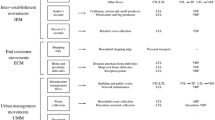Abstract
This paper studies the use of performance indicators in routing problems to estimate how transportation cost is affected by the quality of service offered. The quality of service is assumed to be directly dependent on the size of the time windows. Smaller time windows mean better service. Three performance indicators are introduced. These indicators are calculated directly from the data without the need of a solution method. The introduced indicators are based mainly on a “request compatibility”, which describes whether two visits can be scheduled consecutively in a route. Other two indicators are introduced, which get their values from a greedy constructive heuristic. After introducing the indicators, the correlation between indicators and transportation cost is examined. It is concluded that the indicators give a good first estimation on the transportation cost incurred when providing a certain quality of service. These indicators can be calculated easily in one of the first planning steps without the need of a sophisticated solution tool. The contribution of the paper is the introduction of a simple set of performance indicators that can be used to estimate the transportation cost of a routing problem with time windows.







Similar content being viewed by others
Notes
Other correlation types can also be detected, but for our purpose of identifying a significant trend for such indicators, a linear correlation analysis is considered as adequate.
References
Baldacci R, Toth P, Vigo D (2007) Recent advances in vehicle routing exact algorithms. 4OR: Q J Oper Res 5–4:269–298
Braysy O, Gendreau M (2005a) Vehicle routing problem with time windows, part I: construction and local search algorithms. Transp Sci 39–1:104–118
Braysy O, Gendreau M (2005b) Vehicle routing problem with time windows, part II: Metaheuristics. Transp Sci 39–1:119–139
Cordeau JF, Desaulniers G, Desrosiers J, Solomon MM, Soumis F (2002) VRP with time windows. In: Toth P, Vigo D (eds) The vehicle routing problem, vol 9. SIAM Monographs on Discrete Mathematics and Applications, Philadelphia, pp 157–193
Cordeau JF, Laporte G, Savelsberg M, Vigo D (2007) Vehicle routing. In: Barnhart C, Laporte G (eds) Transportation. Elsevier, North Holland, pp 367–428
Fischetti M, Lodi A, Martello S, Toth P (2001) A polyhedral approach to simplified crew scheduling and vehicle scheduling problems. Manage Sci 47(6):833–839
Gayialis SP, Tatsiopoulos IP (2004) Design of an IT-driven decision support system for vehicle routing and scheduling. Eur J Oper Res 152:382–398
Homberger J, Gehring H (2005) A two-phase hybrid metaheuristic for the vehicle routing problem with time windows. Eur J Oper Res 162:220–238
Laporte G (1992) The vehicle routing problem: an overview of exact and approximate algorithms. Eur J Oper Res 59:345–358
Marcucci E, Danielis R (2008) The potential demand for a urban freight consolidation centre. Transportation 35:269–284
Perboli G, Pezzella F, Tadei R (2008) Eve-opt: an hybrid algorithm for the capability vehicle routing problem. Math Methods Oper Res 68:361–382
Pisinger D, Ropke S (2007) A general heuristic for vehicle routing problems. Comput Oper Res 34:2403–2435
Puckett SM, Hensher DA (2008) The role of attribute processing strategies in estimating the preferences of road freight stakeholders. Transp Res Part E 44:379–395
Solomon MM (1987) Algorithms for the vehicle routing and scheduling problem with time windows constraints. Oper Res 35:254–265
Toth P, Vigo D (eds) (2002a) The vehicle routing problem, vol 9. SIAM Monographs on Discrete Mathematics and Applications, Philadelphia
Toth P, Vigo D (2002b) An overview of vehicle routing problems. In: Toth P, Vigo D (eds) The vehicle routing problem, vol 9. SIAM Monographs on Discrete Mathematics and Applications, Philadelphia, pp 1–26
Wardman M (1998) The value of travel time: a review of British evidence. J Trans Econ Policy 32(3):285–316
Acknowledgments
The authors would like to thank Simone Amico for his fundamental contribution to this work, which has been partially supported by the Ministero dell’Istruzione, Università e Ricerca (MIUR) (Italian Ministry of University and Research), under the Progetto di Ricerca di Interesse Nazionale (PRIN) 2007 “Optimization of Distribution Logistics”. They would also thank Bruno Dalla Chiara and Jesús Gonzalez Feliu for their valuable suggestions on the paper. The authors finally thank the two anonymous reviewers for their useful comments that have significantly improved the quality of the original manuscript.
Author information
Authors and Affiliations
Corresponding author
Appendices
Annex A
Annex B
Rights and permissions
About this article
Cite this article
Deflorio, F.P., Perboli, G. & Tadei, R. Freight distribution performance indicators for service quality planning in large transportation networks. Flex Serv Manuf J 22, 36–60 (2010). https://doi.org/10.1007/s10696-010-9072-1
Published:
Issue Date:
DOI: https://doi.org/10.1007/s10696-010-9072-1








